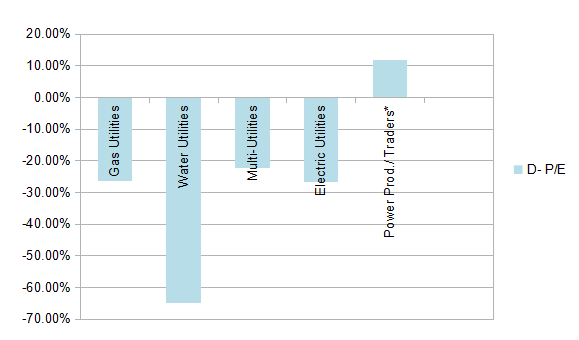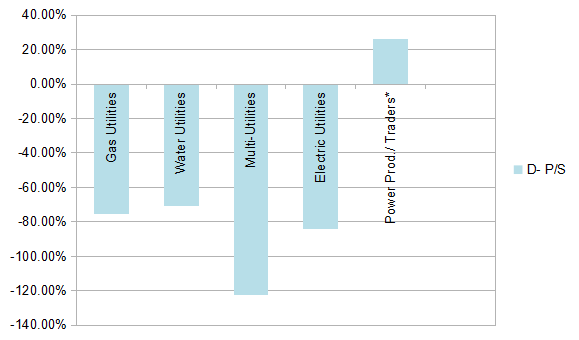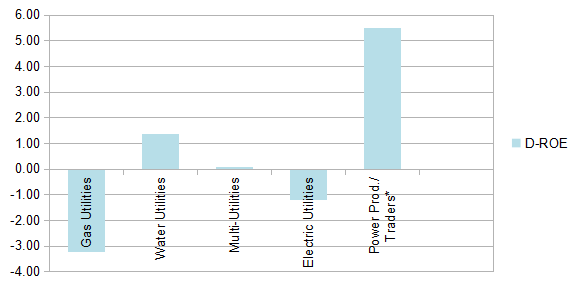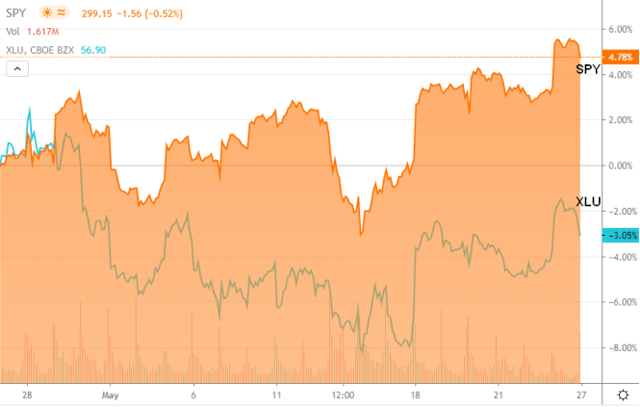Utilities Dashboard - May Edition
by Fred PiardSummary
- Valuation metrics in utilities.
- Evolution since last month.
- A list of stocks looking cheap in their industries.
This article series provides a monthly dashboard of industries classified by sectors. It compares valuation and quality factors relative to their historical averages in each industry.
Executive summary
Combining our valuation and profitability metrics, the most attractive industry in utilities is independent power producers/traders. Other industries are significantly overpriced and profitability doesn’t justify it.
Since last month:
- P/E has deteriorated in all industries of the sector.
- P/S has improved in water, electric and multi-utilities, and deteriorated in gas and power producers/traders.
- ROE has deteriorated in gas and multi-utilities.
- The Utilities Select Sector SPDR ETF (XLU) has lagged the SPDR S&P 500 ETF (NYSEARCA:SPY) by 7.8%.
- On this period, the best performing S&P 500 Utilities stocks are CenterPoint Energy Inc. (CNP), NRG Energy Inc. (NRG), Dominion Energy Inc. (D), Entergy Corp. (ETR), and Exelon Corp. (EXC).
Some cheap stocks in their industries
The stocks listed below are in the S&P 1500 index, cheaper than their respective industry factor for price/earnings and price/sales. The 10 companies with the highest return on equity are kept in the final selection. I update every month several lists like this in various sectors. Quantitative Risk & Value Members have an early access to these lists before they are published in free articles. The list was published for subscribers at the beginning of the month based on data available at this time. This is not investment advice. Do your own research before buying.
| EIX | Edison International | UTILELECTRIC |
| ETR | Entergy Corp. | UTILELECTRIC |
| NRG | NRG Energy Inc. | UTILELECTRIC |
| NJR | New Jersey Resources Corp. | UTILGAS |
| UGI | UGI Corp. | UTILGAS |
| AVA | Avista Corp. | UTILMULTI |
| CNP | CenterPoint Energy Inc. | UTILMULTI |
| MDU | MDU Resources Group Inc. | UTILMULTI |
| AWK | American Water Works Co. Inc. | UTILWATER |
| AWR | American States Water Co. | UTILWATER |
Detail of valuation and quality indicators in utilities on 5/26/2020
I take 3 aggregate industry factors: price/earnings (P/E), price to sales (P/S), return on equity (ROE). My choice has been justified here and here. Their calculation aims at limiting the influence of outliers and large caps. They are reference values for stock picking, not for capital-weighted indices.
For each factor, I calculate the difference with its own historical average: to the average for valuation ratios, from the average for ROE, so that the higher is always the better. The difference is measured in percentage for valuation ratios, not for ROE (already in percentage).
The next table reports the 3 industry factors. There are 3 columns for each factor: the current value, the average (“Avg”) between January 1999 and October 2015 taken as an arbitrary reference of fair valuation, and the difference explained above (“D-xxx”).
| P/E | Avg | D- P/E | P/S | Avg | D- P/S | ROE | Avg | D-ROE | |
| Gas Utilities | 21.79 | 17.24 | -26.38% | 1.70 | 0.97 | -75.67% | 8.28 | 11.49 | -3.21 |
| Water Utilities | 39.07 | 23.68 | -65.01% | 6.73 | 3.94 | -70.76% | 9.32 | 7.96 | 1.36 |
| Multi-Utilities | 20.27 | 16.59 | -22.20% | 2.11 | 0.95 | -122.44% | 9.51 | 9.48 | 0.03 |
| Electric Utilities | 20.21 | 15.94 | -26.79% | 2.25 | 1.22 | -84.08% | 9.24 | 10.43 | -1.19 |
| Power Prod./ Traders* | 30.74 | 34.9 | 11.93% | 3.07 | 4.16 | 26.21% | 0.37 | -5.15 | 5.52 |
* Averages since 2005
The following charts give an idea of the current status of 2 valuation factors (P/E, P/S) and a quality factor (ROE) relative to their historical average in each industry. For all factors, the difference to average is calculated in the direction where positive is good. For valuation ratios, lower is better; for ROE, higher is better. On the charts below, higher is always better.
Price/earnings relative to historical average:

All industries in the sector except power producers/traders are overpriced by at least 20% regarding historical price/earnings.
Price/sales relative to historical average:

Overpricing is even worse in price/sales metrics (except for power producers/traders).
ROE relative to historical average:

The best-looking industry in profitability relative to its historical average is power producers/traders once again. However, in absolute profitability, electric and gas utilities are the best with over 10% in aggregate ROE.
Momentum
The next chart compares the price action of a major ETF in utilities with the benchmark in 1 month.

Chart by TradingView
Most of my stock holdings are based on quantitative value models. However, value is a bad timing indicator. Quantitative Risk & Value (QRV) provides you with a more realistic quantitative approach, for a world of probabilities instead of just risk on/risk off. It includes a systemic risk indicator and strategies based on it. Get started with a two-week free trial and see how QRV can improve your investing decisions.
Disclosure: I/we have no positions in any stocks mentioned, and no plans to initiate any positions within the next 72 hours. I wrote this article myself, and it expresses my own opinions. I am not receiving compensation for it (other than from Seeking Alpha). I have no business relationship with any company whose stock is mentioned in this article.